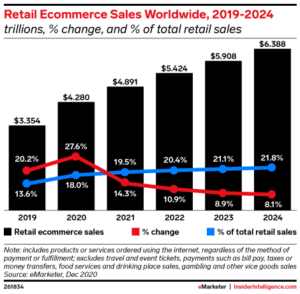Thirty years ago, it was almost impossible to imagine the internet as we know it today. What will the next thirty years look like? When you see the current data and analyze the trends, it’s actually pretty easy to imagine; society will continue to turn to the digital universe for almost everything: ordering food, buying a car, dating, working, and shopping. As you’ll read in the post below, most businesses will be hard-pressed to succeed without an established, multi-faceted, income-generating online presence.

Internet access and usage is rapidly increasing worldwide, causing digital shopping to become more popular every year. In 2020, over two billion people purchased goods or services online. During the same year, eCommerce sales surpassed 4.2 trillion USD worldwide and global online retail sales grew more than 25 percent. Two years ago, only 13.6% of sales were from online purchases. That number is expected to reach 19.5% in 2021, a 45.8% increase in eCommerce market share. Similar growth is expected to continue, reaching 21.8% by 2024, which translates into an 8.2 percentage point increase in just five years.
One of the most visible trends in eCommerce is the unprecedented use of mobile devices. In 2021, smartphones accounted for almost 70 percent of all retail website visits worldwide, and the popularity of mobile/social commerce sources like Instagram and Facebook are rapidly increasing. With mobile traffic currently accounting for over 50% of all eCommerce traffic, it’s safe to assume that mobile is the future of online shopping. In fact, three out of four consumers say they buy from their smartphones because it’s easy and saves time. Furthermore, global eCommerce statistics show that the percentage of consumers using their smartphones for shopping exceeded half of all retail purchases, accounting for 55.4% of global eCommerce sales in 2020.
Watch out, Facebook. Shopify recently announced a partnership with social media’s golden child: TikTok. The partnership was a no-brainer; according to a recent Adweek survey, 49% of TikTok users said they purchased a product after seeing it advertised, promoted, or reviewed at least once on the platform. As of June 2021, TikTok users watched an average of 24 hours of video per month, compared to YouTube’s 22 hours. Imagine how many shoppable products were seen in those 24 hours.
The deal aims to make it easier for Shopify’s over 1 million merchants to reach TikTok’s younger audience and drive sales. The partnership will eventually expand to include other in-app shopping features as well. As part of this effort, Shopify merchants can install or connect their “TikTok Pixel” — a tool that helps them track conversions driven by their TikTok ad campaigns more efficiently. Currently, eCommerce merchants can track user actions like browsing their page, registering on a website, adding items to their cart, placing an order, and completing the payment. The TikTok-Shopify partnership could help the short-form video platform compete against other sources of social commerce, including the growing number of live stream shopping apps and eCommerce efforts from Facebook and its family of apps.
Interested in discussing how eCommerce will benefit your business? We’re happy to help! Contact ed@mittcom.com to get started.
Sources: Statista, Digital Commerce 360, eMarketer, TechCrunch